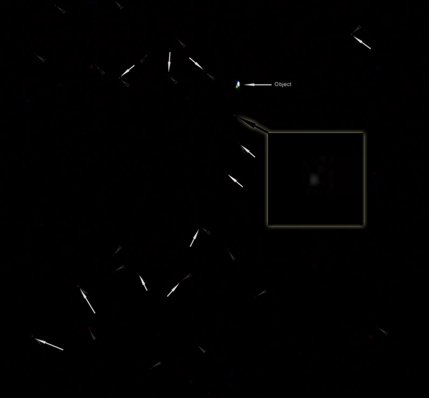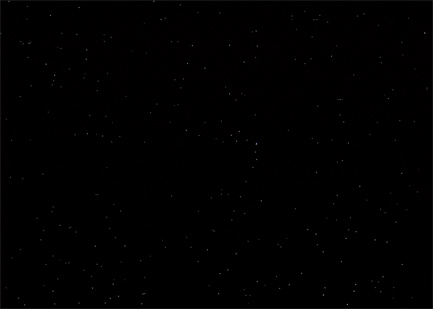Report:
Night Lights = NL, Date: 4th December 2004. Day: Saturday, Time: 8.30 pm approximately & 12.30 am, Location: Map Leanyer, Darwin, Direction: East South East. & moved in a Northerly direction, Duration: 2 hours & 10 minutes, Position: 45 degrees & 60 deg to the horizon, Witnesses: 2 Nigel & Julie plus 4, Colour: Red Green Blue, Shape: Roundish orb, Appearance: Starboard Lights of a plane, Size: Small, How many lights: set of 6 & a set of 3 = 9 in total, Noise: No, Viewed: Naked eye plus Binoculars, Photo: Yes.
After hours of digital analysis I was able to compile an image of what Nigels camera was able to detect “as a light source”.
The brightest object in the image above is the object circled, the reported UFO. Though you can now see the surrounding stars in the above image this was not how the camera was able to process the image or the light being emitted from the stars.
After hours of analysis for any kind of colour variation which might indicate starlight, I feel I was able to identify many points of light that indicate stars. However knowing the un reliability of digital cameras I can not be 100 percent sure this is what it is. I have viewed many UFO digital image sand I feel this image taken by Nigel Lynn is of high quality and worth analysis.
Some have indicated it could be the constellation Peladies or a comet. After hours of re-sampling I was able to formulate these images step by step.
Nigels image was examined with graphic program Abobe photo shop 8. The image below was examined at full program optical zoom 1600% percent. The images was broken into 2 mm sections each section was examined at 1600% percent zoom. Original image size 100.1 cm in width by 70.1 cm in height. Each section of the image revealed light grey to white coloured pixels which could indicate a possible point of light example star light. Each arrow indicates an area where light coloured pixels were found.
In this next image below the arrows point to a much brighter areas of the image where more than one pixel square was definitely identified. This indicated to me Nigels camera was able to pick up points of star light.
Like most reports that come to the Australian UFO Research Network Hotline, they are shared with other researchers in Australia and overseas for an opinion. Kyle King is one such researcher who resides in the US and is very knowledgeable in computer imagery and photographic programs.
Kyle commented that maybe the object Nigel captured could be part of the constellation Peladies.
Taking this into consideration my next step to was to see if Nigel had in some way captured a star which was part of an constellation. In this next series of images you will see how I used a process within the Adobe program allowing me to superimpose an image of the Peladies over the image Nigel sent me.



